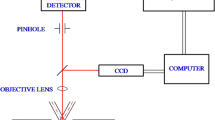Summary
By modifying the technique of vacuolar perfusion, a new method for measuring the motive force of the rotational cytoplasmic streaming inNitella internodes was developed. The motive force, being almost independent of temperature in the range of 10–30‡ C, amounts to 1.4–2.0 dynes/cm2. The decrease in the rate of streaming with decrease in temperature is therefore explained in terms of the increase of cytoplasmic viscosity. Lowering of the tonicity of the cell sap decreases both motive force and rate of streaming, while heightening of tonicity increases both. The cell is without turgor pressure throughout. Inhibition of streaming byp-chloromerocuribenzoate is accounted for by an effect on the motive force, not on the cytoplasmic viscosity.
Similar content being viewed by others
References
Abe, S., 1964: The effect of p-chloromercuribenzoate on rotational protoplasmic streaming in plant cells. Protoplasma58, 483–492.
Hayashi, T., 1957: Some dynamic properties of the protoplasmic streaming inChara. Bot. Mag. (Tokyo)70, 168–174.
—, 1960: Experimental studies on protoplasmic streaming inCharaceae. Sci. Papers College General Education Univ. Tokyo10, 245–282.
Kamitsubo, E., 1966: Motile protoplasmic fibrils in cells ofCharaceae. II Linear fibrillar structure and its bearing on protoplasmic streaming. Proc. Jap. Acad.42, 640–643.
Kamiya, N., 1953: The motive force responsible for protoplasmic streaming in the myxomycete plasmodium. Ann. Rep. Sci. Works Osaka Univ.1, 53–83.
— andK. Kuroda, 1956 a: Velocity distribution of the protoplasmic streaming inNitella cells. Bot. Mag. (Tokyo)69, 544–554.
— —, 1956 b: Artificial modification of the osmotic pressure of the plant cell. Protoplasma46, 423–436.
— —, 1957: Cell operation inNitella. III. Specific gravity of the cell sap and endoplasm. Proc. Jap. Acad.33, 403–406.
— —, 1958: Measurement of the motive force of the protoplasmic rotation inNitella. Protoplasma49, 1–4.
— andM. Tazawa, 1966: Surgical operations on Characean cells with special reference to cytoplasmic streaming. Ann. Rep. Biol. Works, Fac. Sci. Osaka Univ.14, 95–106.
Kishimoto, U., andM. Tazawa, 1965: Ionic composition and electric response ofLamprothamnium succinctum. Plant Cell Physiol.6, 529–536.
Kuroda, K., 1956: Recherches sur la relation entre la pression osmotique de la cellule et le courant protoplasmique. Cytologia21, 200–207.
Nagai, R., andL. I. Rebhun, 1966: Cytoplasmic microfilaments in streamingNitella cells. J. Ultrastruct. Res.14, 571–589.
Tazawa, M., 1964: Studies onNitella having artificial cell sap. I. Replacement of the cell sap with artificial solutions. Plant Cell Physiol.5, 33–43.
Author information
Authors and Affiliations
Additional information
The author wish to express his cordial thanks to Professor N.Kamiya of Osaka University for his valuable suggestions and advice throughout this work.
Rights and permissions
About this article
Cite this article
Tazawa, M. Motive force of the cytoplasmic streaming inNitella . Protoplasma 65, 207–222 (1968). https://doi.org/10.1007/BF01666379
Received:
Issue Date:
DOI: https://doi.org/10.1007/BF01666379



